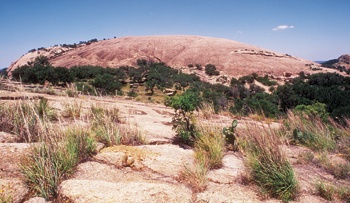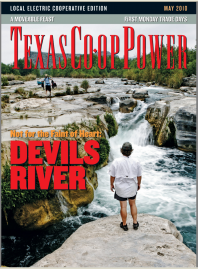On winter solstice, the shortest day of the year, long shafts of soft light poured into the ancient cave atop Enchanted Rock.
Timidly, I entered the cave, a labyrinth of rocks that looks like a long-forgotten Stonehenge structure. Crouching under a low overhang and sliding on my rear end down a slick slice of granite, I stood and surveyed my surroundings: Massive boulders, older and heavier than I’m capable of imagining, bore down on me.
Above me and beside me, I could see ways out of the cave. What I couldn’t see was what held these boulders in place. Some leaned downhill, defying gravity. Others seemed to precariously balance, holding each other in place like mega-ton dominoes that surely, with the slightest shove, would horrifically come tumbling down.
My guide, Gary Verstuyft, a ranger at the Enchanted Rock State Natural Area north of Fredericksburg, stared up at the boulders standing a good 10 feet over his 6-foot frame. “If one of them decided to fall, there’d be no rescue for you and me,” he said. “We’d be one of the artifacts.”
Noting my furrowed brow, Verstuyft smiled reassuringly. “If they haven’t moved in a couple million years,” he said, “I don’t think they’re going to move today.”
But clearly, at some point over the past billion years or so, these rocks have moved. And since early Native Americans discovered this mystical place some 12,000 years ago, people have been moved to climb its biggest rock of all: the oval-shaped granite dome known as Enchanted Rock.
While the rock’s moods may change—on a clear day it looks like a bald head turning pink in the sun; on cloudy days, the granite looms a somber gray—its stone-faced expression never does.
After all, this batholith—a Greek word meaning “deep rock”—was forged by volcanic eruptions more than a billion years ago. Not much can rattle a rock that literally, through the ages, has rolled with the lava flow as it solidified into a solid granite mass slowly exposed by erosion.
But Enchanted Rock, which technically consists of a main granite dome and several smaller ones, is just a rock the same way the Grand Canyon is just a big hole in the ground. Something this enormous—640 acres of Enchanted Rock rise above ground at the 1,643-acre state natural area, and even more of the granite lies hidden beneath Central Texas’ Llano Uplift region—invokes respect.
Native Americans regarded Enchanted Rock “with an awe approaching veneration,” according to Robert Weddle, a contributing author in Enchanted Rock: A Natural Area Survey (Lyndon B. Johnson School of Public Affairs, University of Texas, 1979). The rock’s name is said to have come from the Comanches’ belief, based on the strange night noises they heard, that it was haunted.
For centuries, people have reported hearing ghastly screams and moans and the ghostly beating of drums from the summit. Some say they’ve seen the red flickering glow of spirit fires. Spooky tales have persisted since Anglo-Texans first visited Enchanted Rock in 1829. One legend tells of the spirit of an Indian chief doomed to walk the summit forever as punishment for sacrificing his daughter—the indentations in the rock are his footprints.
The late Lady Bird Johnson gets credit for preserving Enchanted Rock for the public. In 1977, Johnson made an emergency phone call to Patrick Noonan, then president of the Arlington, Virginia-based Nature Conservancy. “Pat, you must come quickly,” she told him, relaying her fears that development of the Enchanted Rock property, which was for sale, would destroy its natural, pristine beauty.
Two days later, Noonan climbed the rock with Johnson, and over dinner at the nearby LBJ Ranch, they discussed ways to defeat far-out development proposals that included, among other things, an amusement park, a Mount Rushmore-like monument to Texas heroes, and town homes along the granite domes.
“We’re not going to lose this wonderful piece of Texas heritage,” Johnson, a dogged conservationist, told Noonan, “and you’re going to help me.”
Based on Johnson’s endorsement, the Nature Conservancy bought the property for $1.3 million in 1978 and deeded the land to the state of Texas. The Enchanted Rock State Natural Area, 17 miles north of Fredericksburg on Ranch Road 965, opened to the public in 1984. The park is a mecca for rock climbers, and in something called bouldering, climbers use crash pads to cushion falls. For those with less extreme appetites, the park’s nine miles of trails offer relaxing hikes. My favorite is the gentle four-mile Loop Trail, which weaves around Moss Lake and Enchanted Rock’s base.
Nowadays, more than 300,000 visitors a year climb Enchanted Rock. For many, including me, the 425-foot pilgrimage up Summit Trail, only six-tenths of a mile long, is a repeated rite of passage. And so it was on December 21, 2009, as strong winds ushered in the first day of winter, that I found myself catching my breath as Verstuyft and I briefly stopped en route to the top.
A middle-aged woman wielding a walking stick overheard Verstuyft say we were about one-third of the way up. “Wrong answer,” she said, laughing, but 20 minutes later, she also easily reached the summit. As dozens of people soaked up the view of the Edwards Plateau, virtually void of development as far as the eye can see, one boy said it all: “You can see forever up here!”
——————–
Camille Wheeler is staff writer for Texas Co-op Power.


